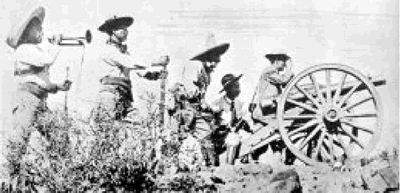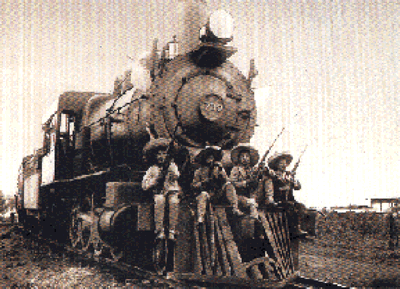Who Did Pancho Villa Fighting Agains
PANCHO VILLA
The Revolutionary Hero

No Photo Credit
In November 1910, the Mexican Revolution began in the state of Chihuahua as poor peasants became frustrated with the high cost of food and continued mistreatment by the rich landowners. This anger had been building for many years and it finally just erupted into violence. The revolutionaries quickly organized and elected their military leaders.
Pancho Villa was voted as a First Commander and led a force of 28 men. Villa was now 32 years old, with much experience leading men who had but one goal in mind, victory. Villa also had the reputation of being one of Mexico's best gunfighters. One of friends later said, "His gun was more important to him than eating and sleeping."
Pancho Villa was quickly seen as a guerrilla fighter and shortly into the war would become one of the most important military leaders of the Mexican Revolution. He was the first revolutionary leader to defeat regular government soldiers. Villa's contingent soon numbered nearly 500 as his men won continual battles.
Villa was also known to not drink, smoke, or take any kind of illegal drug. He was known as a ruthless man whose anger could turn into a raging fury. Villa was loyal to the men he respected and trusted. However if he was betrayed, he would instantly try and sentence the culprit all in one action.

Villa and the Dorados, "the golden Ones", his ferocious cavalry would attack, firing accurately at a full gallop from their charging horses in the style of warfare perfected by the Apache and Comanches who the Dorados' fathers had fought a generation earlier.
By 1913 Villa led a revolutionary force numbering about 3,000. They are known as the División del Norte. They were known for their strong cavalry charges. Villa had now begun successfully attacking at night. This seriously damaged the morale of the federal troops.
Villa was a strong leader who made his presence known to all. He was known to surprise his men and sit down at one of the campfires where they were making their food. He would ask if he could join them and then sat down alongside and eat whatever they had. This made him very popular among the troops and also made sure he would not be poisoned.
The battle for Torreon was to make Villa a national leader. He had sent in 16,000 revolutionary soldiers who attacked night and day. The fighting included much hand-to-hand combat and was very bloody. The federal leaders withdrew about 4,000 troops and replaced them with 6,000 fresh ones. They soon became weary and feared the night attacks. After ten days and nights of engagement, Villa's fighters were rejoicing in their apparent victory as the federal army withdrew to the south.

Col Villa and his troops place themselves under command of Francisco Madero at the Hacienda de Bustillos, Chi. 1911
The battle of Zacatecas would be known as the largest and bloodiest battle during the revolution against Huerta. This was a beautiful city surrounded by hills and several small villages. However, these picturesque streets would soon be filled with flowing blood thousands of dead soldiers and civilians from both sides.
Villa had brought in about 12,000, the federal forces had about as many. His troops began shelling the town from all directions. Cannon shells rocked the town. As the cannons slowed their barrage, some civilians and soldiers came out from behind their shelter only to be hit by a hail of bullets. Reports later said that about 20,000 rifles were showering the town at the same time.
After the fighting, a witness reported seeing hundreds of dead bodies and dead horses in all the city streets. Nearly 1,000 bodies were collected and piled up high. About 500 federal troops, who had surrendered, were taken to a cemetery and shot in the head one by one. In the end the total killed were: 6,000 federal troops, 1,000 revolutionaries, and a large number of civilians had been killed or injured.

Villa continued his victorious assaults against the federal troops for several years more. However, he was going to taste a major defeat in Celaya against Obregon in April of 1915. He had two major problems. First he did not have reinforcements prepared, but if he had, he did not have sufficient ammunition to continue the fighting.
There were actually two battles at Celaya. The first had Villa using his cavalry charges of the past. This proved to be disastrous as Obregon was prepared for charges on horseback and on foot and fought hard to repel the Villista's forty different times. Obregon's machine guns kept spraying the valiant revolutionaries. They finally fell back when Obregon ordered his bugler to sound retreat for the Villasta's. They fell for the trick and abandoned their positions.
This gave Obregon time to prepare for a second battle and the federal troops set up barbed wire fences, filled irrigation ditches with water and hid 6,000 cavalry soldiers in a nearby forest. Villa and his men were overconfident and did no scouting of the area. This proved to be a fatal error as the irrigation ditches slowed the Villista's and the machine guns had target practice. The barbed wire fences also did their job by slowing more soldiers and then the hidden cavalry attacked.
Villa's troops just ran off humiliated, leaving 32 cannon and 3,000 dead comrades. Another 6,000 had been captured, along with 1,000 of their horses. Obregon asked the Villasta officers to identify themselves, promising none would be hurt. One hundred and twenty officers stepped forward and were immediately shot.
With this major defeat, the once proud and victorious División del Norte, had now stopped being a major military force for Pancho Villa. He was now retreating to northern Mexico, where he had been victorious in days gone by. He was still not accepting the fact that his army had also been beaten morally.
Villa financed his army by stealing cattle herds in northern Mexico and selling them north of the border, where he found plenty of American businessmen willing to sell him guns and bullets. Faced with a sluggish economy, he issued his own money; if merchants refused to take it, they risked being shot.
Mex Rev. soldier and his family along railroad tracks
Villa became a sort of folk hero in the U.S. Even Hollywood filmmakers and U.S. newspaper photographers flocked to Northern Mexico to record his battles--many of which were staged for the cameras.
Even as Villa was quickly becoming a legend, he was still thinking of the terrible loss at Celaya. Rumors were spreading that President Wilson had aided Obregon and Carranza in their defeat of Villa. This was reportedly done by allowing them to use U.S. railroads to transport their troops to Celaya. Perhaps the Americans were hoping the Mexicans would kill each other off.
Villa may have also thought this as he decided to fight Americans, instead of fellow Mexicans. A few months later he attacked Columbus, New Mexico in March of 1916.
Katz, Freidrich, Katz. The Life and Times of Pancho Villa. Stanford University Press, 1998.
The Assassination
Corridos de Pancho Villa
 Return to Jaime's Home Page
Return to Jaime's Home Page
lawrenceproom1949.blogspot.com
Source: https://www.laits.utexas.edu/jaime/jrn/cwp/pvg/revolutionary.html
0 Response to "Who Did Pancho Villa Fighting Agains"
Post a Comment